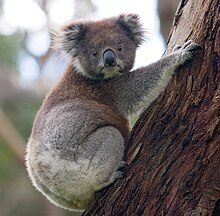
Back Koalol (Phascolarctidae) AVK Koalalar Azerbaijani Коалови Bulgarian Phascolarctidae Breton Fascolàrctids Catalan Koalovití Czech Phascolarctidae Spanish Phascolarctidae Basque کیسهخرسان Persian Koalat Finnish
| Phascolarctidae[1] Temporal range:
| |
|---|---|

| |
| Phascolarctos cinereus | |
| Scientific classification | |
| Domain: | Eukaryota |
| Kingdom: | Animalia |
| Phylum: | Chordata |
| Class: | Mammalia |
| Infraclass: | Marsupialia |
| Order: | Diprotodontia |
| Suborder: | Vombatiformes |
| Infraorder: | Phascolarctomorphia Aplin & Archer, 1987 |
| Family: | Phascolarctidae Owen, 1839 |
| Genera | |
The Phascolarctidae (φάσκωλος (phaskolos) - pouch or bag, ἄρκτος (arktos) - bear, from the Greek phascolos + arctos meaning pouched bear) is a family of marsupials of the order Diprotodontia, consisting of only one extant species, the koala,[1] and six well-known fossil species, with another six less well known fossil species, and two fossil species of the genus Koobor, whose taxonomy is debatable but are placed in this group. The closest relatives of the Phascolarctidae are the wombats, which comprise the family Vombatidae.[2]
The fossil record of the family dates back to the Middle Miocene[3] or Late Oligocene.[4]
- ^ a b Groves, C. P. (2005). "Family Phascolarctidae". In Wilson, D. E.; Reeder, D. M (eds.). Mammal Species of the World: A Taxonomic and Geographic Reference (3rd ed.). Johns Hopkins University Press. p. 43. ISBN 978-0-8018-8221-0. OCLC 62265494.
- ^ Groves, C. P. (2005). "Suborder Vombatiformes". In Wilson, D. E.; Reeder, D. M (eds.). Mammal Species of the World: A Taxonomic and Geographic Reference (3rd ed.). Johns Hopkins University Press. pp. 43–44. ISBN 978-0-8018-8221-0. OCLC 62265494.
- ^ Benton, M.J. (2005). Vertebrate Palaeontology. Oxford. p. 314.
- ^ Cite error: The named reference
Black2012was invoked but never defined (see the help page).